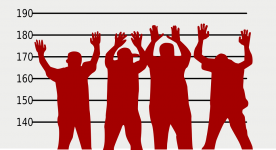How Reliable is Identification Evidence?

Eyewitness testimony is commonly used in hearings and trials to assist the prosecution to secure a conviction.
However, in recent years a number of wrongful convictions have been made on the basis of unreliable eyewitness testimony, casting doubt on whether or not it should hold any weight in court.
In a several cases, innocent people have received lengthy prison sentences simply because the evidence of a single eyewitness is often given greater weight than other types of evidence.
Research has shown that eyewitnesses may be more likely to wrongly identify a person where that person has a different racial background to them, or where factors such as bad lighting and the presence of weapons come into play.
How reliable is eyewitness testimony?
Several of our previous blogs have discussed the Innocence Project, which seeks to exonerate individuals who have been wrongly convicted.
Statistics compiled by that organisation suggest that eyewitness evidence is the ‘greatest contributing factor to wrongful convictions, playing a role in about 75% of convictions overturned through DNA testing worldwide.’
But what makes eyewitness testimony so unreliable?
Various studies have shown that the unreliability of eyewitness evidence can largely be attributed to the fallibility of a person’s memory. We recently published a blog about the issues associated with memory which showed that memories often deteriorate over time and may be influenced by other factors such as emotion and exposure to new information about a suspect or a case.
In other instances, issues such as racial bias may have a negative impact on a person’s ability to identify the correct suspect. Scientific studies have shown that most of us experience difficulties when it comes to identifying people from other racial groups – this is commonly known as the ‘cross-race effect.’
Studies in the United States have revealed that African-Americans in particular suffer directly as a result of the cross-race effect. In one American case, a woman who was sexually assaulted at her college campus by a black male was adamant that she had correctly identified the man from an identification parade.
Ronald Cotton was convicted of the assault and spent 11 years in prison until DNA evidence revealed that another man, Bobby Poole, was actually responsible.
Cotton was then released, but many others have not been so lucky – DNA technology is relatively new, so it’s impossible to say how many wrongful convictions have been made in the past. Statistics from the Innocence Project show that cross-race misidentifications played a role in about 30% of all cases where a wrongful conviction was made.
Other studies show that in cases involving a weapon such as a gun, witnesses are more inclined to focus their attention on the weapon rather than the person holding it. With less focus on the person’s physical appearance, there is a greater potential for them to wrongly identify the person at a later stage. This phenomenon is known as ‘weapon focus.’
Each of these factors detracts from a person’s ability to correctly identify the perpetrator of a crime – whether during an identification parade, or when giving evidence before a court. Unfortunately, juries tend to place more weight on eyewitness testimony than other forms of evidence, which may increase the likelihood of a person being wrongly convicted.
The Far-Reaching Consequences of Incorrect Eyewitness Testimony
Thankfully, the story of Ronald Cotton had a happy ending – Cotton now travels around the US with the complainant, Jennifer Thompson-Cannino, educating others about the issues associated with eyewitness testimony, and they have even penned a book together.
However, hundreds of other cases – particularly in America – reveal the tragic flaws associated with eyewitness evidence.
In one case, Guy Miles, a 31-year-old African-American says that he was wrongly convicted of a 1998 bank robbery in California. Miles had previously served time behind bars, however he had been released the previous year and relocated to Las Vegas in a bid to turn over a new leaf – and he was in Vegas at the time of the incident.
Eyewitnesses alleged that Miles was at the scene of the crime there was no other material evidence for the prosecution. The witnesses were only able to provide brief, ambiguous descriptions of the men involved in the robbery. One eyewitness even admitted to police that he wouldn’t be able to correctly identify the man as he had been struck in the face with a gun and pushed to the ground.
Yet despite this, police told the witnesses to choose mugshots resembling the robbers from a pile of photos. Miles’ photo was one of several chosen by the witnesses.
At trial, the witness who had chosen Miles’ photo told the court that ‘he looks different.’ But the jury wasn’t present in court for this startling revelation. Prosecutors had a meeting with this witness and asked her to look at the mugshot again – following this, she made a positive identification before the jury.
Miles was sentenced to 75 years to life in prison, and has remained there ever since. Though his story is upsetting, it is one of many which reveal deficiencies in eyewitness testimony.
What Should be Changed?
The problems associated with eyewitness testimony have led to organisations advocating for changes in the way eyewitness evidence is used.
One method which they suggest authorities adopt is the double-blind sequential method, which requires witnesses to examine each suspect one at a time, rather than in a group. For each suspect, witnesses are asked whether they recognise the person – which means that they have to make a judgment about that person immediately.
The method has been adopted in part in Australia – witnesses are now normally shown individual pictures of people on a video screen rather than a bunch of people on a photoboard. But the words that are used by police can vary, and there have been instances where leading questions have been asked.
Statistics how that the double-blind method leads to lower rates of misidentification.
Juries in Australia are also warned about the potential unreliability of identification evidence; but whether jurors heed those warnings rather than rely upon an honest, yet mistaken, identification by an eyewitness is another matter.






